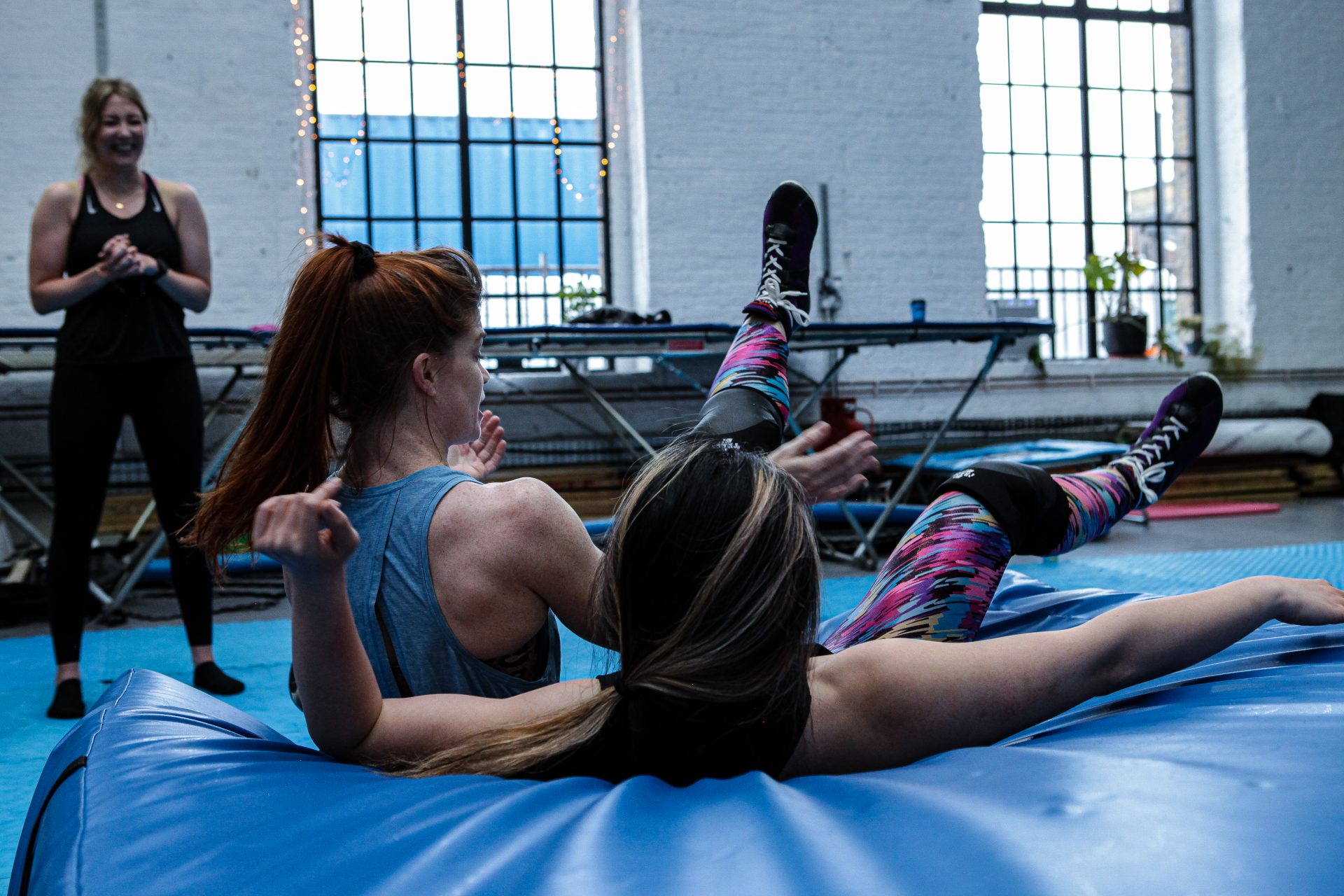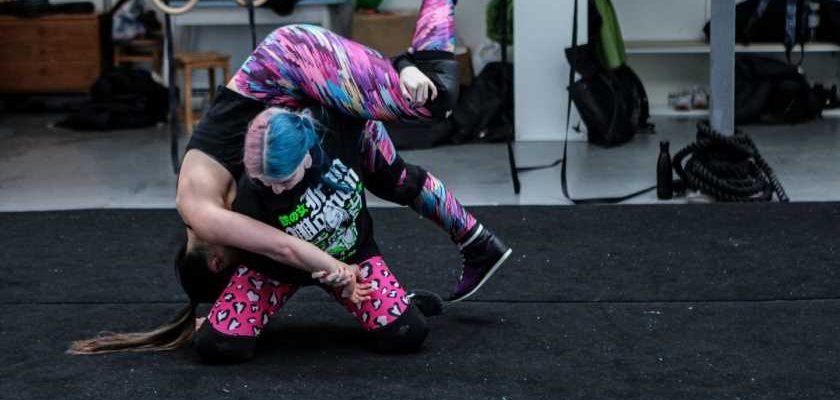“Enrolling in a wrestling school was the best thing I’ve ever done for my confidence”
With shows like Glow introducing female wrestling to a whole new audience, writer Danielle de Wolfe enrols in a wrestling school to experience the ultimate workout.
When I think of the words ‘professional wrestling’, I instantly envisage abs smothered in baby oil, eye-wateringly tight unitards and, well, Hulk Hogan. In case that wasn’t a giveaway, I freely admit that my knowledge of the cult ‘sport’ doesn’t run particularly deep. In fact, it wasn’t until a few months ago, having stumbled across WWE: Smackdown on late-night television (subsequently sending me down an internet wrestling wormhole) that I realised the extent of the professional wrestling fandom.
I use the word ‘sport’ in inverted commas because it’s something of a contentious issue. The non-competitive nature of wrestling ensures it bears more resemblance to a soap opera, despite some members of the community perpetuating the idea that wrestling is a real sport. Notably a storytelling experience, wrestling features recurring characters, ongoing narratives and immersive story arcs – despite the sheer physicality of life inside the ring.
You may also like
How women are shaking up the world of wrestling
It wasn’t a concept I’d pondered a great deal until I found myself hit (quite literally) by a wrestling revelation somewhere on the outskirts of Woolwich, London, on a drizzly Sunday morning. Now, I can say with conviction, wrestling is one of the most thorough full-body workouts I’ve ever experienced. And yes, wrestlers of all shapes and sizes should be considered athletes.
Granted, it’s not every day you find yourself starfished at the centre of a wrestling ring in the name of journalism. Nor is it all that common to undertake a workout where you’re taught how to ‘strike’ and ‘bump’ under the watchful eye of a professional WWE star.
However, a growing thirst for wrestling – in part, thanks to the popularity of Netflix’s Glow and women’s pro-wrestling events promoted by EVE – has spawned a new generation of wrestlers. Feminist wrestlers. Leading to the creation of projects like Play Fight, the project offers a safe space for women, non-binary and non-cis male-identifying individuals wishing to experience the immersive world of wrestling first-hand.




Set up by former elite gymnast and campaigner Claire Heafford alongside her partner, professional wrestler Tom Dawkins (aka Cara Noir to UK wrestling fans), Play Fight was conceived at the height of lockdown.
Following a wave of sexual and physical abuse allegations that rocked the wrestling industry – surfacing on Twitter using the hashtag #SpeakingOut – the school has become something of a positive takeaway. Its foundations and guidelines built upon the findings of the parliamentary report into the abuse, which Dawkins contributed evidence to.
Wrestling: where to begin?
Providing a friendly environment in which to train, Play Fight caters to all manner of gender identities and experience levels. Classes range from beginner sessions through to more advanced mixed classes, covering technical training, grading and even advanced workshops for independent professional wrestlers. Being an utter novice myself – and feeling more than a little daunted by the idea of grappling complete strangers, I joined their ‘Shake The Table’ session. Designed to build confidence as well as accommodate those who have experienced such abuse, the class is, without a doubt, one of the most supportive workouts I’ve trialled.
“I felt that as an athlete, I needed to compete with the men, so I’d always resisted the idea of being in an all-female environment,” explains Heafford. “But being in lockdown, having had a baby and having lost my confidence, there was no way I could have gone into a class with men.”




And so Shake The Table was born. Described as the ideal way to “get hench, kick butt and unleash your inner superhero”, the session begins with introductions: names, pronouns and the question: ‘How does training give you pleasure?’
It’s a diverse class, with fellow attendees including a fireman, make-up artist, charity campaign manager and Hollywood actor. It’s all run by Heafford, with the assistance of professional wrestler Samantha Allen, aka Nina Samuels. A seamless blend of gymnastic skills, grappling techniques, theatrical performance and calisthenic elements, wrestling is the epitome of a full-body workout.
What does it take to start wrestling?
“It’s a family,” says Heafford of wrestling, noting the shared bond held by all those in attendance. Splitting the class into pairs, our warm-up is what many would consider to be a full-on HIIT workout. From wheelbarrow sprints and fireman’s lifts to sit-ups and piggyback squats, if your thighs aren’t burning by the end of this, chances are, you’re doing something wrong.
While those with experience step straight into the ring with Allen, I undertake a crash-course in ‘rolls’ (used as transitions between wrestling set-ups) and ‘bumps’ (the dramatic act of a wrestler hitting the ground). Taking to the crash mats, it quickly becomes clear that safety is paramount, whatever stage of wrestling you’re at. Protecting your neck and landing in a way that minimises impact is key, with wrestling grades being not so much about achievement as they are about ensuring the safety of your partner. It’s a guarantee your opponent is knowledgeable enough to keep you safe.
Describing wrestling as “a completely alternate reality”, Heafford explains that performers either play ‘goodies’ or ‘baddies’. “You’re either going to look totally glam, over-the-top and amazing or as mean and nasty as possible,” says Heafford. Noting the art attracts women en-masse because it allows them to play with the grotesque, she describes the rise of female wrestling as “a real anti-fitness movement”.
Women are told to be less confident than men – in life and the ring
“Women are enculturated to underestimate what they’re capable of. And men, generally, overestimate their capabilities,” says Heafford. “We have a Grade One class on a Tuesday night and all of these guys could take part in it,” she says, surveying the class. “But it’s just that the men come in so confident; the more confident they are, the more the women step back. And you really see it in the ring.”
The second half of the two-hour session is dedicated to blocking out sequences, more advanced manoeuvres and technical skills. With four stations, it’s pretty much a pick ’n’ mix of what wrestling has to offer.
Cheered on by my fellow wrestlers, I learn how to master a ‘suplex’ – a type of bump where a wrestler picks up their opponent and then uses their own body weight to drive their opponent to the floor. Lifting my partner into the air, I launch them over my head and onto a crash mat – not a usual part of my Sunday morning routine. I also learn how to ‘post’ – the art of wrestlers easing the burden on their partner during lifts by distributing their weight – and discover more about the ring (each spring-loaded wrestling ring has a unique level of bounce to it). “Some can be like hitting concrete,” laughs Heafford casually.

Blocking through sequences, it becomes clear just how much of an art form wrestling is. It’s a technical illusion. It’s an endurance workout. But first and foremost, it’s a way to unleash an alter-ego in a safe, non-judgmental environment. Not only requiring enough upper and lower body strength to keep your opponent safe during choreographed throws and routines, it’s a confidence-boosting experience that feeds into the outside world.
Granted, I entered the ring thinking this was going to be something of a painful experience – and yes, the following day my upper body did feel as though I’d gone 10 rounds with Mike Tyson. But what the world of wrestling offered was a community, far less focused on appearances and far more concerned with support, shared enjoyment and celebrating achievement.
You can find out more about Play Fight, their classes and bump your way into the world of wrestling by popping on to their website.
For more fitness stories, visit the Strong Women Training Club.
Images: Emma Fitzgerald
Source: Read Full Article
